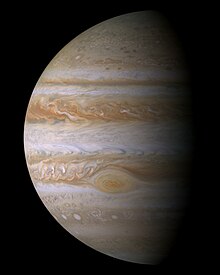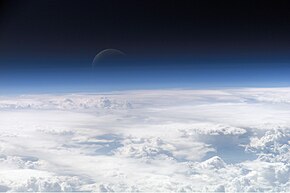వాతావరణం: కూర్పుల మధ్య తేడాలు
Ahmed Nisar (చర్చ | రచనలు) →ఇతరాలు: తర్జుమా మరియు వికీకరణ |
Ahmed Nisar (చర్చ | రచనలు) తర్జుమా మరియు వికీకరణ |
||
| పంక్తి 1: | పంక్తి 1: | ||
[[Image:PIA04866 modest.jpg|thumb|right| |
[[Image:PIA04866 modest.jpg|thumb|right| [[బృహస్పతి]] యొక్క వాతావరణ దృశ్యం. ఇందులోని [[:en:Great Red Spot|ఎర్ర మచ్చ]].]] |
||
'''వాతావరణం''' : (ఆంగ్లం : '''atmosphere''') : ద్రవ్యరాశి కలిగిన ఒక శరీరం చుట్టూ వాయువులతో కూడిన పొరను ''వాతావరణం'' అంటారు.<ref>[http://www.ontariosciencecentre.ca/school/clc/visits/glossary.asp Ontario Science Centre website]</ref> ఈ శరీరానికి వున్న ఆకర్షణ శక్తి ఎక్కువగానూ, వత్తిడి తక్కువగానూ ఉన్న మూలంగా, వాతావరణ పొర ఆ శరీరానికి అంటిపెట్టుకొని వుంటుంది. కొన్ని గ్రహాలు తమ వాతావరణంలో అనేక వాయువులను కలిగివుంటాయి. |
'''వాతావరణం''' : (ఆంగ్లం : '''atmosphere''') : ద్రవ్యరాశి కలిగిన ఒక శరీరం చుట్టూ వాయువులతో కూడిన పొరను ''వాతావరణం'' అంటారు.<ref>[http://www.ontariosciencecentre.ca/school/clc/visits/glossary.asp Ontario Science Centre website]</ref> ఈ శరీరానికి వున్న ఆకర్షణ శక్తి ఎక్కువగానూ, వత్తిడి తక్కువగానూ ఉన్న మూలంగా, వాతావరణ పొర ఆ శరీరానికి అంటిపెట్టుకొని వుంటుంది. కొన్ని గ్రహాలు తమ వాతావరణంలో అనేక వాయువులను కలిగివుంటాయి. |
||
| పంక్తి 5: | పంక్తి 5: | ||
== భూమిపై వాతావరణం== |
== భూమిపై వాతావరణం== |
||
[[Image:Top of Atmosphere.jpg|thumb|290px|right|వాతావరణ వాయువులు, తమ తరంగదైర్ఘ్యం కంటే ఎక్కువ నీలి కాంతిని వెదజల్లుతాయి. శూన్యం నుండి చూస్తే భూమి నీలి గోళంగా కానవస్తుంది.]] |
|||
[[Image:Top of Atmosphere.jpg|thumb|290px|right|Atmospheric gases scatter blue light more than other wavelengths, giving the Earth a blue halo when seen from space.]] |
|||
The [[Earth's atmosphere]] consists, from the ground up, of the [[troposphere]] (which includes the [[planetary boundary layer]] or peplosphere as lowest layer), [[stratosphere]], [[mesosphere]], [[thermosphere]] (which contains the [[ionosphere]] and [[exosphere]]) and also the [[magnetosphere]]. Each of the layers has a different [[lapse rate]], defining the rate of change in temperature with height. |
The [[Earth's atmosphere]] consists, from the ground up, of the [[troposphere]] (which includes the [[planetary boundary layer]] or peplosphere as lowest layer), [[stratosphere]], [[mesosphere]], [[thermosphere]] (which contains the [[ionosphere]] and [[exosphere]]) and also the [[magnetosphere]]. Each of the layers has a different [[lapse rate]], defining the rate of change in temperature with height. |
||
12:42, 5 జనవరి 2009 నాటి కూర్పు

వాతావరణం : (ఆంగ్లం : atmosphere) : ద్రవ్యరాశి కలిగిన ఒక శరీరం చుట్టూ వాయువులతో కూడిన పొరను వాతావరణం అంటారు.[1] ఈ శరీరానికి వున్న ఆకర్షణ శక్తి ఎక్కువగానూ, వత్తిడి తక్కువగానూ ఉన్న మూలంగా, వాతావరణ పొర ఆ శరీరానికి అంటిపెట్టుకొని వుంటుంది. కొన్ని గ్రహాలు తమ వాతావరణంలో అనేక వాయువులను కలిగివుంటాయి.
భూమిపై వాతావరణం

The Earth's atmosphere consists, from the ground up, of the troposphere (which includes the planetary boundary layer or peplosphere as lowest layer), stratosphere, mesosphere, thermosphere (which contains the ionosphere and exosphere) and also the magnetosphere. Each of the layers has a different lapse rate, defining the rate of change in temperature with height.
Three quarters of the atmosphere lies within the troposphere, and the depth of this layer varies between 17 km at the equator and 7 km at the poles. The ozone layer, which absorbs ultraviolet energy from the Sun, is located primarily in the stratosphere, at altitudes of 15 to 35 km. The Kármán line, located within the thermosphere at an altitude of 100 km, is commonly used to define the boundary between the Earth's atmosphere and outer space. However, the exosphere can extend from 500 up to 10,000 km above the surface, where it interacts with the planet's magnetosphere.
ఇతరాలు
ఇతర అంతరిక్ష శరీరాలు, వాతావరణాన్ని కలిగివున్నాయి. క్రింద వాటి జాబితా ఇవ్వబడినది.
మన సౌరమండలములో
- బుధుని వాతావతణం
- శుక్రుని వాతావతణం
- చంద్రుని వాతావతణం
- అంగారకుని వాతావతణం
- బృహస్పతి వాతావతణం
- Io వాతావతణం
- యూరోపా వాతావతణం
- గనీమీడ్ వాతావతణం
- శని యొక్క వాతావతణం
- టైటాన్ వాతావతణం
- ఎన్సెలాడస్ వాతావతణం
- యురేనస్ వాతావతణం
- నెప్ట్యూన్ వాతావతణం
- ట్రైటాన్ వాతావతణం
- ప్లూటో వాతావతణం
- భూమి వాతావతణం
ప్రాముఖ్యత
From the perspective of the planetary geologist, the atmosphere is an evolutionary agent essential to the morphology of a planet. The wind transports dust and other particles which erodes the relief and leaves deposits (eolian processes). Frost and precipitations, which depend on the composition, also influence the relief. Climate changes can influence a planet's geological history. Conversely, studying surface of earth leads to an understanding of the atmosphere and climate of a planet - both its present state and its past.
For a meteorologist, the composition of the atmosphere determines the climate and its variations.
For a biologist, the composition is closely dependent on the appearance of the life and its evolution.